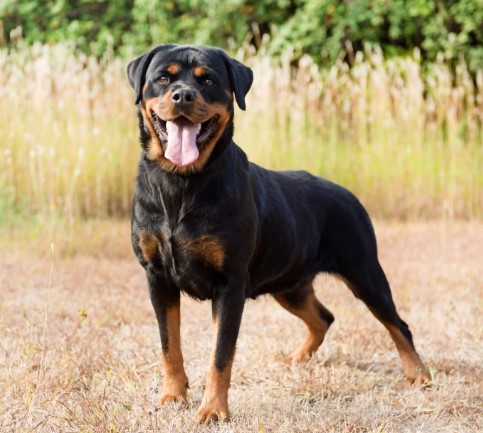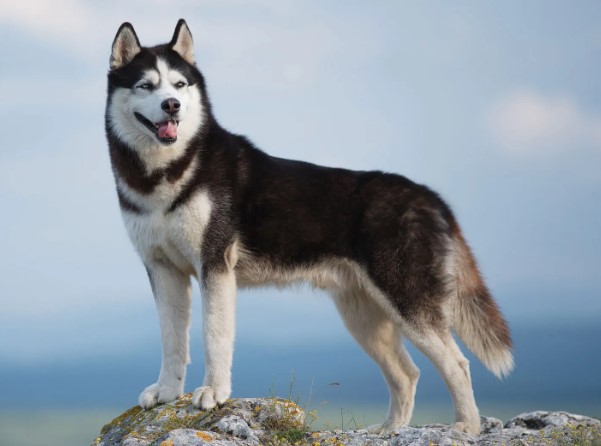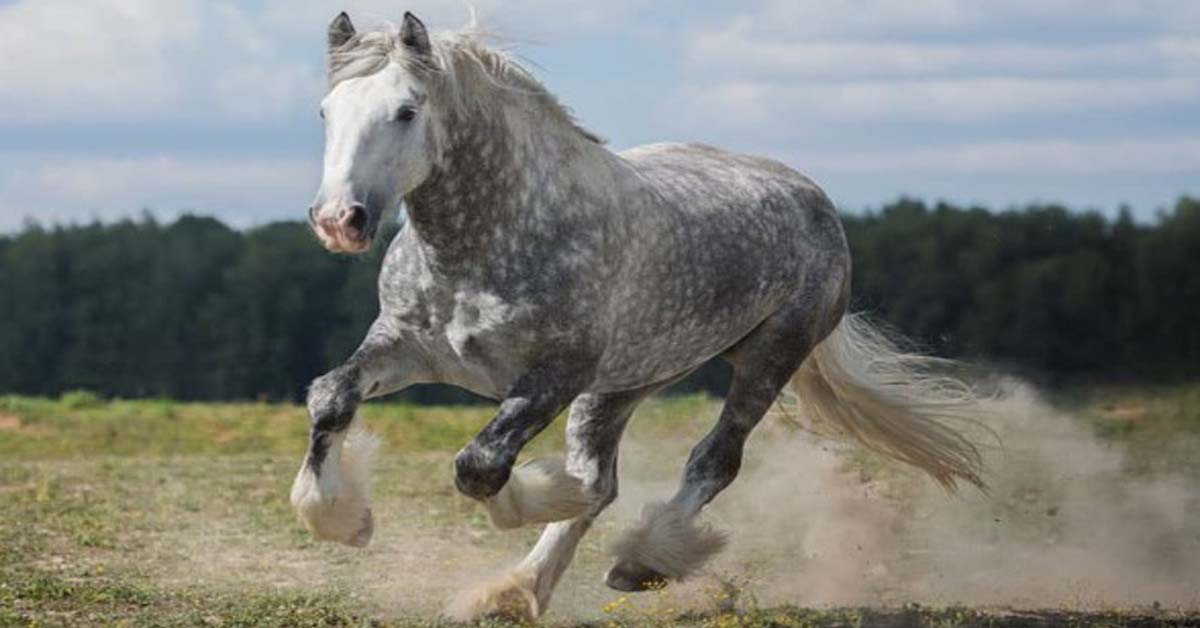The Saint Bernese is a colossal mixed-breed canine from the combination of the St. Bernard and the Bernese Mountain Dog. Both parent breeds are classified as giant dogs, and the Saint Bernese inherits their substantial stature. Due to their size, these dogs may find apartment living unsuitable and require ample opportunities for exercise.
Despite their large size, Saint Bernese dogs are cherished as wonderful family companions due to their gentle and remarkably patient nature. They easily form strong bonds with young children. Both parent breeds have a history of being effective working dogs, contributing to the Saint Bernese’s trainable nature. While training them can be straightforward, it is advisable to employ patience, and positive reinforcement techniques, and opt for brief training sessions for optimal results.
Regrettably, the Saint Bernese breed has a relatively short lifespan ranging between 6 and 10 years and is susceptible to various health conditions such as hip dysplasia, cancer, and bloat. Their size also predisposes them to certain spinal issues.
- Height: 26-35 inches
- Weight: 100-120 pounds
- Saint Bernese Lifespan: 6-10 years
- Colors: White, brown, black
Saint Bernese Mountain Dog Breed Characteristics
The Bernese Mountain Dog, substantial, significant, and purposefully built for labor, also possesses a striking beauty and a gentle, sweet nature. Despite their generally calm demeanor, Berners are always up for playful antics with their owners, as they take immense joy in pleasing them.
This large and robust working dog can tower over 27 inches at the shoulder. Adorned with a tricolored coat of dark, crisp white, and rust, the Bernese Mountain Dog’s thick, silky, and moderately long fur, along with distinctive markings on the face, serves as a breed hallmark. The intelligent gleam in their dark eyes adds to their overall majestic and noble appearance.
Originating from the granges and ranges of Switzerland, the Bernese Mountain Dog is a robust canine that excels in cold and rainy conditions. Their mental acuity and strong muscles allowed them to multitask in their working roles. Berners are amiable with the entire family, displaying a special gentleness towards children. However, they often form a particularly strong bond with one fortunate individual.
While Bernese Mountain Dogs are discerning, they are not aloof, and they maintain a composed demeanor with strangers.
| Energy: 4 |
| Trainability: 4 |
| Health: 3 |
| Lifespan: 3 |
| Sociability: 5 |

History Of Saint Bernese
While the exact origins of the Saint Bernese remain uncertain, its development is thought to have originated in the 1990s, coinciding with a surge in the popularity of crossbreeding canine varieties. These dogs are relatively uncommon in the United States, and understanding their history entails examining the backgrounds of their parent breeds, the Saint Bernard and the Bernese Mountain Dog.
The history of Saint Bernard dates back to the 1600s when monks first recognized the breed’s proficiency in tracking in the snowy Swiss mountains. The dogs were instrumental in locating lost travelers, providing warmth by lying beside them. Unfortunately, through inbreeding and maladies, many of these dogs were lost. In the 1830s, efforts to revive the breed involved crossing with Newfoundlands to fortify its characteristics. Introduced to England in 1810, Saint Bernards made their way to America by 1880.
The Bernese Mountain Dog, the other parent breed of the Saint Bernese, is believed to have originated when Roman Mastiffs, brought during the Roman invasion of Switzerland, interbred with the local sheep-guarding dogs. This resulted in a breed capable of withstanding cold and rain while serving as an adept guard and farm dog.
Although records trace back to the 1800s, the Bernese Mountain Dog was officially recognized and studied by Professor Albert Heim, ultimately making its way to America by 1926. The breed gained recognition from the AKC in 1937.
Appearance
Due to its hybrid nature, the Saint Bernese inherits substantial size from its two large parent breeds, often weighing 120 pounds or more and reaching an average height of 27 units.
Females are slightly smaller than males, ranging between 110 and 170 pounds with a height of 26 to 32 units, while males can exceed 180 pounds and measure between 26 to 35 units in height.
Built for the laid-back lifestyle they were originally bred for, Saint Bernese dogs boast solid, muscular bodies with a broad chest and sturdy legs. Their proportions are well-balanced, with bodies longer than their height. Their noses are prominent, and they feature large, round eyes typically in black or dark brown hues.
Characteristic of the Saint Bernese are their notably large, round paws, comparable in size to those of bears. Additionally, they sport droopy ears that frame their face. The medium-length, dense, and waterproof coat comes in various colors, including brown, black, and cream.
Temperament
Saint Bernese pups make ideal family companions, especially for households with young children. Despite their considerable size, they possess a remarkably gentle and mellow demeanor, known for their calm and affectionate nature. Although they may exhibit playfulness, Saint Bernese puppies take longer to mature compared to some other breeds, retaining a puppy-like charm for an extended period.
Their excellent suitability for families with small children stems from their high tolerance, patience, and inherent sense of security. Originating from a lineage of defenders, tracing back to their role as rescuers of lost travelers, these dogs showcase remarkable intelligence, facilitating relatively easy training.
Training a Saint Bernese proves to be a delightful yet straightforward task with patience and time, as the breed, while obedient, can also exhibit a stubborn streak. Short and engaging training sessions, employing positive reinforcement, work best for this intelligent breed, which thrives under the guidance of a consistent master and benefits from regular tasks.
Despite their fantastic qualities as family dogs, prospective adopters should consider Saint Bernese’s substantial size. While they are gentle and affectionate, they require ample physical activity to expend their considerable energy. Apartment living may not be the most suitable environment for them, as they thrive in settings where they can engage in daily walks and have room to run.
While not hyperactive, they do need regular exercise, and a canine park or home play area is recommended. Supervision is crucial around small children due to their size. However, they happily settle down in the evenings if kept active during the day.
Given their lineage of working dogs, Saint Bernese dogs flourish in homes with ample space, making a ranch or estate an ideal setting. Nonetheless, any home with sufficient indoor and outdoor space can accommodate these delightful companions.
Personality
Saint Bernards are affectionate and calm companions. Their innate warmth often alleviates any initial apprehension from strangers approaching such a large dog. However, Saint Bernards are quick to sense danger and instinctively protect family members they perceive to be in peril.
Their friendly, gentle, and tolerant nature makes Saint Bernards particularly suitable for families with well-behaved children. Renowned for their exceptional patience and discernment, Saint Bernards are mindful not to cause harm to children.
Their eagerness to please makes training relatively straightforward compared to other breeds.
Health Of Saint Bernese
The Saint Bernese breed is susceptible to a range of health issues commonly encountered by other large dog breeds, with the added risk of inheriting health problems from both parent breeds. However, many of these ailments can be mitigated through regular veterinary check-ups and awareness of potential vulnerabilities.
Minor health concerns for Saint Bernese dogs may include allergies, obesity, and occasional eye infections. Additionally, hyperthyroidism can sometimes be diagnosed in this breed.
Major health issues to be aware of include cancer, bloat, and spinal issues. Another condition they may inherit is von Willebrand Disease, a blood clotting disorder caused by a deficiency of von Willebrand factor, a protein crucial for blood clotting. Similar to hemophilia in humans, this disorder can result in excessive bleeding following even minor injuries, such as small cuts.
Like many large breeds, Saint Bernese dogs are also prone to common problems such as hip dysplasia. While this condition has a hereditary component, managing weight, nutrition, and exercise can help alleviate its effects. It’s crucial not to over-exercise Saint Bernese puppies until their bones are fully developed to prevent exacerbating joint and hip issues in the future. Regular monitoring and preventive measures can help ensure the health and well-being of these beloved companions.

care Of Saint Bernese
To maintain optimal health for your Saint Bernard Bernese Mountain Dog mix, it’s essential to schedule regular veterinary appointments—at least once a year is recommended.
During these routine check-ups, your dog will undergo a comprehensive physical examination and receive essential vaccinations to prevent diseases such as parvo, distemper, rabies, and kennel cough. As your dog ages, it’s advisable to consider yearly bloodwork to monitor their health more closely.
Ensuring your pet is spayed or neutered at the appropriate age is also important for their overall well-being.
Additionally, keeping your Saint Bernese up to date on flea and heartworm prevention is crucial. Consult with your veterinarian to determine the most suitable products for your dog, as dosages are typically based on weight, making prevention measures for larger dogs more costly than those for smaller pets.
Best Food For
- Hill’s™ Science Diet™ Adult Oral Care
- Hill’s™ Science Diet™ Adult Chicken & Barley Entrée Dog Food
- Hill’s™ Science Diet™ Adult Small & Toy Breed
- Hill’s™ Science Diet™ Puppy Healthy Development Small Bites Lamb Meal and Rice Recipe
Grooming
Both the Saint Bernard and Bernese Mountain Dog, the parent breeds of the Saint Bernese, possess double-layered coats that provide insulation against harsh mountain climates. Similarly, the Saint Bernese inherit a long and thick coat designed to protect them in cold conditions. Regular grooming is essential for this breed, typically requiring daily brushing, especially during shedding seasons when brushing may need to be done twice a day.
It’s common for this mixed breed to develop skin folds around the mouth area, which should be cleaned daily to prevent infections.
Maintaining good oral hygiene is vital for all dog breeds, so make sure to brush your Saint Bernese’s teeth at least twice a week. Additionally, limit baths to when absolutely necessary, as excessive bathing can strip the dog’s coat of its natural protective oils.
Given their large, floppy ears, keeping them clean is important to prevent ear infections. Use a damp cloth to gently wipe away any excess wax or dirt. Regular grooming and hygiene practices will help keep your Saint Bernese healthy and comfortable.
Training
Saint Bernese dogs are intelligent and eager to please their owners. However, they can also exhibit a stubborn streak and independence, which may pose challenges during training, especially for inexperienced owners.
Utilizing positive reinforcement techniques is highly effective with this breed. To prevent boredom and ensure better training outcomes, it’s recommended to keep training sessions short and engaging. Providing a variety of stimulating toys can help redirect their energy away from constant chewing and playing.
Training is particularly crucial for dogs of this size to prevent jumping up on people during greetings. Additionally, recall training is essential, especially in open spaces like dog parks, where their natural inclination to roam may lead them astray. Consistent and patient training will help foster a well-behaved and obedient Saint Bernese companion.
Exercise
Both parent breeds of the Saint Bernese were originally bred for their resilience and ability to withstand cold climates. With their thick, long, double-layered fur, they excel in harsh winter conditions, providing excellent insulation against cold winds and snow. However, they are not well-suited to hot weather, and their exercise needs may vary depending on the temperature.
For those who enjoy mountain walks, particularly during colder months, the Saint Bernese is an ideal companion breed.
These large dogs require ample exercise to maintain their fitness and health. Ideally, they should have access to a decent-sized yard to freely roam and play. Daily walks are essential, with durations of around 30 minutes per session, twice a day.
Saint Bernese dogs typically prefer longer walks over short runs, but they can adapt to agility-style activities and may enjoy chasing toys.
Exploring the countryside is a favorite activity for these dogs, as it aligns with their instincts. This makes them excellent companions for hikers and outdoor enthusiasts.
When selecting toys for your Saint Bernese, opt for hard rubber and larger toys, as they may quickly destroy smaller ones. Providing a variety of durable toys will help keep them entertained and engaged.
Adoption Center Of Saint Bernese
Other Dog Breeds and Further Research
Saint Bernese FAQs
Is a Saint Bernard the same as a Bernese mountain canine?
The crucial differences between Saint Bernard and the Bernese Mountain Dog(a.k.a. Berner) are size, appearance, lifetime, origin, and disposition. Saint Bernards are constantly larger and heavier than Bernese mountain tykes. also, while Saint Bernard and Bernese mountain tykes are related, their origin is distinct.
What 2 dogs make a Bernese mountain dog?
It’s allowed that the four Swiss Sennenhund types( Appenzeller Sennenhund, Entlebucher Sennenhund, Greater Swiss Mountain Dog, and Berner Sennenhund) developed as crosses between ranch tykes from the Swiss mounts and the Molosser or Mastiff- type tykes that the Romans brought with them when they raided the mounts in the.
What’s a great Bernese?
The Great Bernese is a large canine with a regal presence. It generally weighs between 70 and 115 pounds. When fully grown, Great Berneses grow to be between 24 and 28 elevations altitudinous. They’ve sturdy and muscular shapes that are hidden under their long and ample fleece.
What dog is bigger than a Bernese mountain dog?
Differences in Coat and Personality
According to the Greater Swiss Mountain Canine strain standard, manly Swissies can be over 28.5 elevations altitudinous at the shoulder, and they weigh between 115 and 140 pounds. The Berner is slightly lower with males measuring up to 27.5 elevations altitudinous and importing between 80 and 115 pounds.
Is a Bernese a good family dog?
The Bernese mountain canine is patient, calm, tender, and a great pet for families, though they can be kindly frosty with strangers. However, Berners get on well with pussycats and other tykes, If duly mingled when youthful.












4 thoughts on “Saint Bernese || Mountain Dog Breed Full Information…”